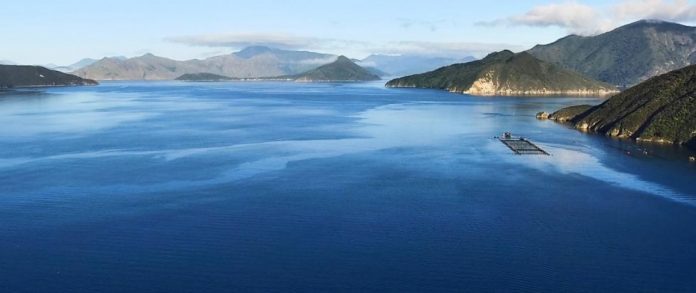Export numbers, offiically, may not add up to growers’ counts, but New Zealand King salmon is clearly on course for more market share
After presenting product to South Korea — dubbed “Asia’s fastest-growing farmed-salmon market” by Canadian growers — New Zealand King salmon has made small but noteworthy gains against competing Atlantic salmon at home and abroad.
New Zealand, the country, exported about 3,645 tonnes of salmon worth about NZD 63 million so far this year, according to government export numbers that didn’t add up. The industry’s advocacy put 2011 numbers at 5,600 t. The steep drop (or discrepancy) seems to be tied to the forced move by official order of production to more open waters, a process now underway.
Meanwhile, just one company — The New Zealand King Salmon Co. — grew its full-year 2017 share of the domestic market by 24 percent to 4,047 t with just 4.4 percent market growth. The increased market share was attributed to “sales of New Zealand produced salmon supported by reduced sales of imported salmon”, NZKS leadership said recently.
Company sales volumes to North America in 2017 were up 38 percent on sales to 800 restaurants alone (all NZ companies sold a combined 500 t worth NZD 9.5 million in the U.S.). Retail sales to Canada and the U.S. “have (only) now commenced”, management said in November 2017, when they added that sales to Singapore, Japan, China and Europe were also up for the year.
As of September 2017 — year-end for earnings reports Down Under — harvest volumes were up 15 percent for NZKS, with fish produced from new sites “larger” than before. Company EBITDA guidance for 2018 is upwards of NZD 26 million, as “demand greater than supply creates opportunity for gradual and ongoing price increases”.
King salmon
All King salmon in New Zealand live their first year in a fresh water hatchery before transferring to salt-water farms clear of native species, a circumstance that makes it easier to keep them healthy in their 20-meter-deep pens. In May 2017, Korean and U.S. buyers were shown fillets from market-sized salmon of up to 6 kg that pack 20.7 percent protein for every 100-gram slab.
“We can raise our salmon naturally without having to resort to chemicals or antibiotics,” a local salmon-farming advocacy quotes itself as saying. “As a species, our King (also called Pacific or Chinook) salmon offer the highest natural oil content of all salmon varieties, including beneficial Omega 3.”
At least four exporters — Akaroa Salmon, High Country Salmon, Sanford and NZKS — appear available for hopeful Asians or Americans who tasted King salmon for the first time recently at the National Restaurant Association Show and Seoul Food & Hotel. High Country Salmon sells hot-smoked, cold-smoked, whole and filleted salmon.
Good pricing
In a brief two weeks ago, Sanford reported “good pricing improvements” for salmon, helping it to an EBIT for the full-year ending in September 2017 of NZD 64 million, up slightly over 2016 but 20 percent better than in 2015.
“As a result of (a brand launch) we are now delivering an additional 15 percent to 20 percent gross margin on our salmon offerings under the Big Glory Bay brand versus last year, with 11 outlets now selling this brand,” analysts were told.
With margins so good, “debt-free” NZKS listed on the New Zealand and Australian stock exchanges in October 2016 and easily raised NZD 30 million in growth capital. It’s EBITDA for full-year 2017 was NZD 21.6 million, or up 35 percent over 2016 on 20 percent more revenues (up to NZD 136.4 million).
Total volumes sold were 7,223 t, or up 1,000 t over 2016 on the strength of NZKS’s four brands: Ora King, Regal, Marlborough King Salmon and New Zealand King Salmon.
NZKS’s reported mortality rates were down to 8.5 percent from 13.7 percent last year. As a result, company assets have increased fivefold to NZD 158.7 million.
By 2021, NZKS “sales and harvest” are “on-track” to be 9,500 t. By then, the regulated relocation of several of its farms to better aerated areas is expected to have a dramatic upward effect on production.

